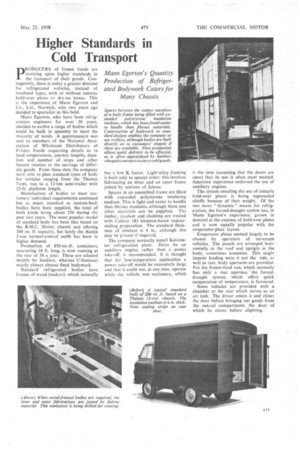Higher Standards in Cold Transport
Page 45

If you've noticed an error in this article please click here to report it so we can fix it.
pRODUCERS of frozen foods are insisting upon higher standards in the transport of their goods. Corisequently, there is today a greater demand for refrigerated vehicles, instead of insulated types, -with or without eutectic hold-over plates or dry-ice boxes. This is the experience of Mann Egerton and Co., Ltd., Norwich, who two years ago decided to specialize in this field.
Mann Egerton, who have been refrigeration engineers for over 30 years, decided to evolve a range of bodies which could be built in quantity to meet the majority of needs. A questionnaire was sent to members of the National Association of Wholesale Distributors of Frozen Foods requesting details as to load temperatures, journey lengthis, duration and number of stops and other factors relative to the carriage of different goods. From these data the company were able to plan standard types of body for vehicles ranging from the Thames 7-cwt, van to a 12-ton semi-trailer with 25-ft. platform length.
Manufacture of bodies to meet customers' individual requirements continued but as many standard as custom-built bodies have been supplied, the total of bmth kinds being about 250 during thz past two years. The most popular model of standard body has been that based on the B.M.C. 30-cwt. chassis and Offering 200 Cu. ft. capacity, but lately the Austin 3-ton normal-control outfit has been in higher. demand.
Production of 850-cu-ft. containers, measuring 18 ft. long, is now running at the rate of 30 a year. These are selected mainly by hauliers, whereas C-licensees nearly always choose fixed bodywork.
Standard refrigerated bodies have frames of wood (makori), which naturally has a low K factor. Light-alloy framing is built only to special order: this involves fabricating an inner and an outer frame joined by sections of Jahroc.
Spaces in an assembled frame are filled with expanded polystyrene insulating medium. This is light and easier to handle than fibrous insulants, although these and other materials can be supplied. The timber, insulant and cladding are treated with Coldset 183 bitumen-based vapoursealing preparation. The standard thickness of insulant is 4 in., although this may be greater if required. .
The company normally install Kelvinator refrigeration plant. Drive by an auxiliary engine, rather than a power take-off, is recommended. It is thought that for low-temperature application a power take-off would be excessively large and that it could not, in any case, operate while the vehicle was stationary, which
is the time (assuming that the doors are open) that its use is often most wanted. American experience endorsed the use of auxiliary engines.
The system entailing the use of eutectic hold-over plates is being superseded chiefly because of their weight. Of the two more " dynamic " means for refrigeration, the forced-draught system has, in Mann Egertpn's experience, grown in demand at the expense of hold-over plates and is now equally popular with the evaporator-plate layout.
' Evaporator plates seemed largely to be chosen by operators of ice-cream vehicles. The panels are arranged horizontally in the roof and upright in the body, sometimes crosswise. This might impede loading were it not tha' side, as well as rear, body apertures are provided. For the frozen-food van, which normally has only a rear aperture,' the forceddraught system, which offers quick recuperation of temperature, is favoured.
Some vehicles are provided with a chamber at the rear which serves as an air lock. The driver enters it and closes the door before bringing out goods from the cernral compartment, the door of which he closes before alighting.


































































































